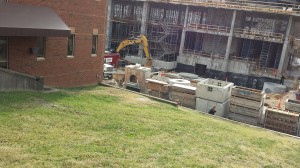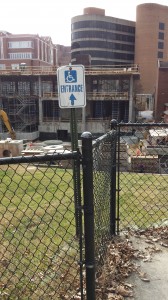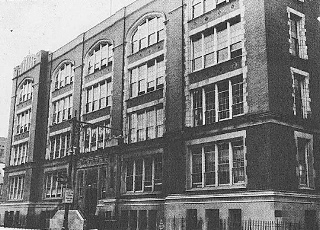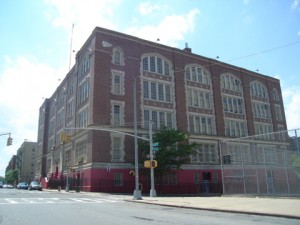It’s that time–high school reunion. This year its my (shudder) 40th. I’ve heard from a number of old friends, some of whom I haven’t seen in perhaps more than those 40 years, so I think it a good occasion to give some account of myself with as much of a tip of the hat to my alma mater as I can muster.
Undergrad Years, 1969-1972
After graduating from Bx Science in the rather turbulent year of 1969 I headed for an even more turbulent place, the University of Wisconsin at Madison. A few other Science grads accompanied me–off the top of my head Rena Robbins and Shelley Falik. The VietNam War was heavy upon us, at some point I hope to share some of my experiences through those events and years. For now, I’ll say that although I started off as a science major, social pressures and imminent military service kept my thoughts elsewhere. Through clouds of tear gas and watching armored personnel carriers trundle through downtown streets, I experienced as much educationally outside the classroom as in.
Another Science grad, David Fine, became infamous as a member of the gang that brought urban terrorism to Madison. In late 1970, he and his partners detonated a bomb which destroyed the Army Math Research Center and in the process killed a promising young post-doc named Robert Fassnacht. If you’re interested, here’s one link to what happened:
Madison, Army Math Research Center
The following year, I joined a group of UW students in trying to make sense of all this by inviting a stellar cast of dozens of the most famous people in the world to participate in a Wisconsin Student Association Symposium. Much to my surprise, most of the invitees accepted and I found myself in the company of George McGovern, Nathan Glazer, Paul Samuelson, Jimmy Breslin, Anthony Lewis, James Farmer, George Wald and Pete Seeger (!).
Shelley (Science 69) was one of the organizers and gets the credit for convincing Pete Seeger to come. Shelley invited Pete to attend a pot luck dinner at his house, and after eating a humble meal (beans of various kinds is about all I recall of the menu), Pete picked up his banjo and led us in a sing-along. The following day, Pete held his “talk” which unsurprisingly turned into a concert. But towards the end, Pete thrust his microphone in front of Shelley’s mouth and said (paraphrasing after these several decades), “Why did you invite so few women to speak at this event?” Shelley looked mortified, that deer-in-the-headlights stare for a few moments. Then he said quite simply, “We were wrong”. Pete Seeger smiled and said, “There is the beginning of wisdom” and went on with the concert.
I hope I’ll have more to say on the topic of this symposium elsewhere in my blog.
Grad School
Life went on and I graduated from the UW in December 1972 with a few accomplishments. Earned a Phi Beta Kappa key and an award for best undergraduate thesis. In my senior year, I had developed an affection for ancient Jewish history. So I ignored my admissions letter to the UW Law School and headed for Israel with hardly a penny to my name. I attended the Ulpan (Hebrew Academy) affiliated with the World Union of Jewish Students in Arad. While there, at synagogue on the Day of Atonement, our rabbi faced us and said, “I regret to inform you that Israel has been attacked on all sides by the armed forces of Syria, Jordan and Egypt. I volunteered for service and they immediately found a suitable job for me: picking weeds out of pepper fields. After two weeks of this, the war over, I returned to Ulpan.
From there I enrolled in the Master’s program in Classical History at Tel Aviv University. I didn’t have the mandatory Latin facility, so they insisted that I take their first-year Latin class. My grad advisor informed me, with more than a twinkle in his eye, that I was very “fortunate” because for the first time elementary Latin was being taught to Hebrew-speaking students using a Hebrew textbook. I’m not sure how much Latin I learned in that class, but I can say without fear of exaggeration that that was where I learned Hebrew.
After a grueling but fabulous year at Tel Aviv, I realized that I had to return to the States to have any hope of an academic career. Much to my surprise, UC-Berkeley not only accepted me, but offered me a full-ride fellowship, so I landed in Berkeley in 1974. In another weird coincidence, David Fine (our Science-grad bomber) was also living in Berkeley at the time. The authorities finally caught up with him, so there I was in San Francisco reading about his arrest and trial.
I received my MA in Near Eastern Languages and Lit in December, 1976 and began my doctoral studies in Berkeley’s Group for Ancient History and Mediterranean Archaeology. My studies were going well, and I spent another year traveling. I received a year’s doctoral fellowship from Hebrew University in Jerusalem in 77/78 and the following year was admitted to the graduate and rabbinic programs of the Hebrew Union College (Cincinnati).
But in 1979 I had some personal problems related to my mother’s medical condition and the simple reality that these were not good times for students of the Humanities, and I took leave of UC-Berkeley. It was supposed to be temporary, but as has happened to so many back then, it has stretched to decades.
Early Career
During my last grad years at UC, I had begun to teach Hebrew and Jewish Studies at a new school for adult Jewish students called Lehrhaus Judaica. When I left UC, the Hillel Foundation and Lehrhaus offered to hire me full time. By day, I managed the business activities of the Foundation, and at night I taught. Lehrhaus spread over the entire San Francisco Bay Area and for my last several years there I rode circuit teaching at Stanford, San Francisco State and Berkeley. Although these were adult classes, we were reviewed by the University of Judaism and my Hebrew classes along with several other courses taught by Fred Rosenbaum and Marty Ballonoff were awarded credit-worth status. So those few of my students who wanted it could earn academic credit.
Marriage
In late 1982, I met the love of my life, Theresa (Terri) Lee. Our first encounter was in one of my Hebrew classes, and yes, I did occasionally date my students. Never the ones taking the class for a grade, of course. Terri was a post-doc in UC-Berkeley’s Psychology Department and had come to study with Irv Zucker. But she somehow found some time to take my Hebrew class and stuck with it, she said, because I was one of the best stand-up comedians she had ever heard. We married a year later. The rabbi made a mistake in the community newspaper and invited everyone to our wedding, so instead of the 100 we thought would attend, there were about 350!
First Child
On September 16, 1985, my first-born entered the world. Reluctantly. Shoshana was a breach baby, and Terri had to be carried kicking and screaming into surgery for the C-section. Terri, who operated on animals on a daily basis, knew what surgery was like and she was having none of it. But we chanted Hebrew verb tables together and she came through it as did my beautiful daughter whom we named Shoshana Frances. That day, by the way, was Rosh HaShanah, one of the holiest days of the Jewish calendar. I had been scheduled to read from the Torah to an audience of more than 600, but some lucky person had to fill in for me. I think that must have been Rabbi Ballonoff, but if he was upset, he never let on.
Moving to Michigan
After 14 glorious years in Berkeley, there was a serious decision to be made. I had this wonderful but quite wacky career as a Jewish educator, but Terri was invited to join the University of Michigan as an Assistant Professor. In my mind there was no comparison, and off to Michigan we went. Terri, Shoshana, my dog Lucy, our cat Teddy and our three rabbits, Pesah, Bilhah and Zilpah. We found that we couldn’t afford a house in Ann Arbor, so we bought a small house on 11 acres just outside town. We’re still in it 18 years later, and I’m typing this into my computer in my office in that house. We finally were able to get DSL about two years ago, so I’m not using dial-up!
Terri rose from Assistant Prof to Associate. Then she was promoted to Professor. They made her the Chair of the Biopsychology group and then the Chair of the Undergrad program. Now she is Department Chair. Psychology is the largest department in the University and the numbers are mind-boggling. 8000 enrolled students ( 25% of incoming first year students in the college get at least one of their undegraduate degrees in Psych). She’s also been co-director of the University’s Sheep Farm and published an armload of papers. Her own lab has something like 40 post-docs, grad students and undergrads toiling away on her sheep and rodent projects.
OK, this is supposed to be autobiographical, so what happened to me?
Of course I would have liked to have taken up where I left off in Berkeley, but it was abundantly clear to me on my arrival that Michigan’s chapter of the Hillel Foundation was doing just fine without me. I probably could have tried making something happen at one of the smaller schools, but after 14 years I thought it was time for something different. I did manage to keep a foot in the teaching of Judaica. Soon after our arrival, someone who knew of me from Berkeley–a Science grad for that matter, Barry Gross–invited me to teach at Congregation Kehillat Israel in Lansing, Michigan and I’ve taught there ever since. But unlike Berkeley, I wasn’t going to be making a living here that way.
One of my students at our Stanford campus was a highly placed executive in the Oracle Corporation. Someone who had been there from the beginning and was a personal friend of Larry Ellison. He was contemplating early retirement and doing graduate work in Judaica and we became good friends. One day he asked me whether I’d like to learn about Oracle and that started me on a path of study to become a database administrator.
On my arrival in Michigan, I discovered that the school had just signed a license for Oracle but had no one who actually knew how to use it. (There were a few departments who had used it prior to the campus-wide agreement, but no one in the primary IT department was familiar with it.) So I was hired to bring up the first Oracle database in the University’s administrative area.
A few years later, in April of 1991, our second child, Ephraim Robert joined the family.
I moved from database administrator to departmental manager at the College of Engineering and eventually was appointed Director of Operations in 2006. After a few health problems and administrative headaches beyond the call of duty, I decided on early retirement in 2007. After about 6 weeks of retirement I went back to work. Nothing to do with the current financial mess, I just didn’t take to an unstructured life very well. My current job is far cry from my former position. I help University faculty and staff acquire the software they need to get their jobs or research done. For the first time ever I have a cube instead of an office and no one to supervise. But I work on a team with some very fine people and the work is far less stressful than my former position.
As it turned out, this was a good place to be now that we are in the grips of some pretty terrifying financial times. If the financial climate improves I think I’ll get back to some good retirement planning. I want to spend more time working on Web sites for organizations I support like the National Alliance on Mental Illness and our small Ann Arbor Model Railroad Club. I’m doing a re-write of the book on Classical Hebrew I wrote for my class at Berkeley’s Lehrhaus Judaica. So there’s no lack of things to occupy me, just a lack of things that pay.
The family continues to grow. Karl Malcolm proposed to and subsequently wed Shoshana in August of 2008 (photo elsewhere in this blog). Shoshana became a registered nurse and is now doing the sacred work of healing at the VA hospital in Madison, Wisconsin. Ephraim will soon be graduating from Dexter High School and is planning to spend his first college year in Israel.
I’m in regular contact with at least one other Science grad–Rabbi Jay Lapidus, who runs a small but vibrant discussion group on Yahoo called “OCR Jewish”.
So that’s my news thus far. I’ve had a marvelous life so far, and I’m looking forward to many more happy times. As I write this, I don’t know whether I’ll be able to get to our 40th reunion or not, but I hope to hear from some of my old friends any time!
 The door closed and locked behind me. I was on a grassy hill. Below me was a ledge, about four feet higher than the corridor running along side the building. Looking up the hill I could see a fence, about 5 feet tall. I walked up the hill and down the hill. The gates at the top were padlocked, the ledge at the bottom was continuous, there were no stairs or other means of getting off the hill.
The door closed and locked behind me. I was on a grassy hill. Below me was a ledge, about four feet higher than the corridor running along side the building. Looking up the hill I could see a fence, about 5 feet tall. I walked up the hill and down the hill. The gates at the top were padlocked, the ledge at the bottom was continuous, there were no stairs or other means of getting off the hill. Yes, that wheelchair entrance sign is indeed located behind the fence I would have needed to climb to exit that direction.
Yes, that wheelchair entrance sign is indeed located behind the fence I would have needed to climb to exit that direction.

